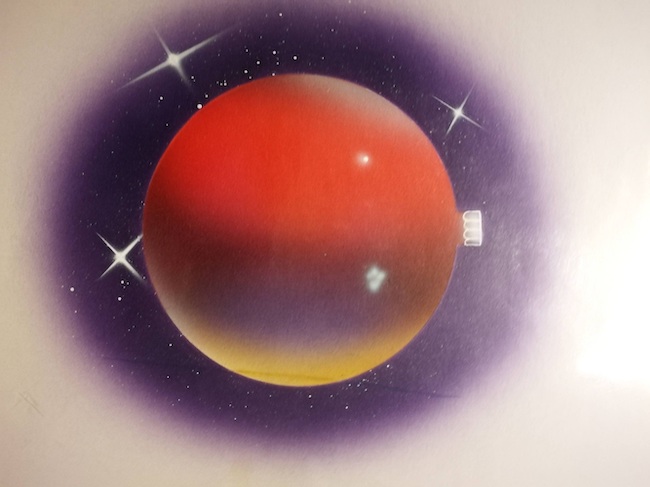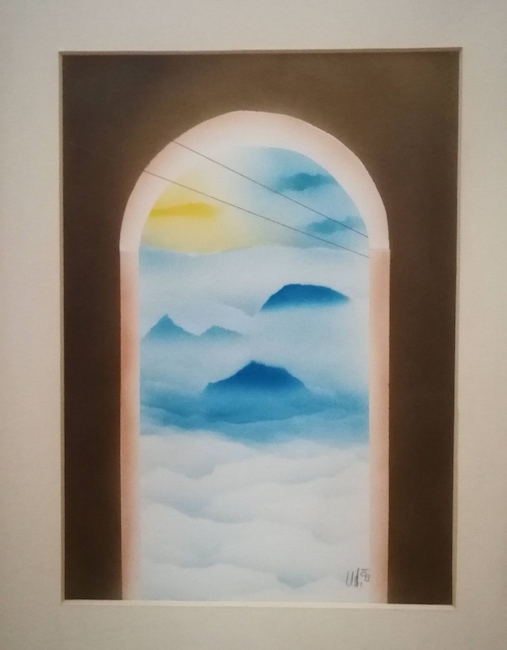Nel corso della storia dell’arte moderna sono state scoperte tecniche artistiche in grado di rivoluzionare la modalità creativa e che mescolate alle incalzanti innovazioni espressive sono riuscite a dar vita a inediti linguaggi, sulla base della naturale inclinazione di ciascun esecutore di un’opera. Il protagonista di oggi ha basato tutta la sua produzione su un particolare approccio pittorico che ha costituito più avanti uno dei punti fermi di alcuni movimenti artistici successivi.
L’Aerografia è una modalità pittorica utilizzata probabilmente fin da epoche remote, quelle primitive in cui le pitture rupestri spesso mostravano impronte di mani contornate da pigmenti rossastri; ovviamente la tecnica era rudimentale e molto lontana dal perfezionamento e l’ampliamento che ha avuto intorno agli anni Cinquanta del Novecento, quando alcuni artisti hanno cominciato a sperimentare la pittura ad aria su un’ampia gamma di superfici. Inizialmente nata come tecnica industriale per la colorazione veloce di grandi superfici e sulle carrozzerie delle automobili, ben presto l’Aerografia ha cominciato a essere utilizzata per dare colore alle fotografie in bianco e nero, parliamo dunque del periodo antecedente alla scoperta della tecnica a colori, rivestendo via via maggior interesse nel mondo sperimentatore dell’arte di fine Ottocento e inizi Novecento. Fu però con la Pop Art e il Fotorealismo americano che cominciò a essere considerata una forma d’arte o parte del processo creativo di alcuni artisti dell’epoca; dai muri alla carta, dal legno ai metalli, dalla pelle ai tessuti, la pittura a spruzzo ha affascinato molti esponenti non solo della Pop Art e del Fotorealismo ma anche dell’Iperrealismo e poi successivamente anche della Street Art contemporanea. Il processo complicato consiste non solo nel creare dei fogli protettivi del contorno dell’immagine che l’artista desidera creare, bensì anche nella stesura uniforme del colore gestendo in maniera magistrale lo spruzzo della pistola ad aria fondamentale per questa tecnica; i fogli protettivi sono stati i progenitori degli stencil, creati dagli street artist che necessitano, vista la natura trasgressiva del loro modo di fare arte, di velocità esecutiva per evitare di essere colti in flagrante. L’apparente semplicità esecutiva si accompagna a una grande capacità nel disegno grafico, base essenziale per la realizzazione finale dell’opera, e dal saper dosare la pittura per sovrapporre gli strati senza coprire completamente i sottostanti, dando così vita a immagini tridimensionali e coinvolgenti; spesso utilizzata anche nelle realizzazioni grafiche e pubblicitarie questa tecnica rappresenta un completamento di uno stile più classico, per così dire più manuale, del dipingere che però non disdegna l’innovazione e la completezza di una finitura più patinata, utilizzando colori coprenti o acrilici. L’artista austriaco Harald Wiesner è stato un pioniere di questa tecnica negli anni Ottanta del Novecento, un maestro che ha saputo coniugare la sua passione per l’Astrattismo Geometrico in cui molto spesso emergono connotazioni metafisiche, alla tecnica dell’Aeorgrafia; la sua abilità nell’utilizzare il getto ad aria stupisce e al tempo stesso affascina l’osservatore che viene attratto all’interno dei concetti che dalle opere fuoriescono.
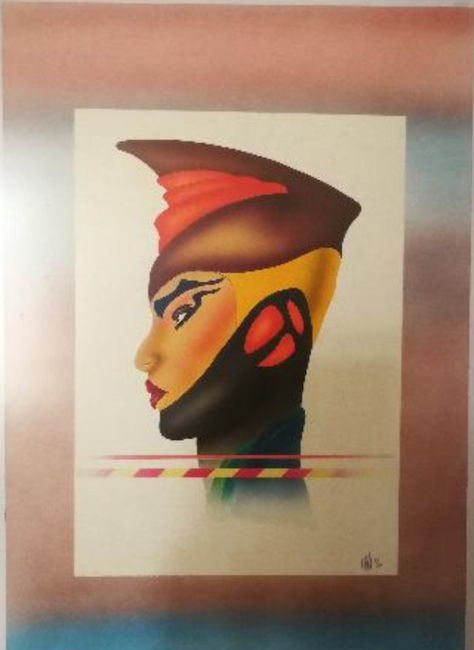
Tutti rigorosamente su carta, i dipinti di Wiesner sembrano essere un’analisi del vivere contemporaneo, quel bilanciamento tra realtà e immaginario, tra pragmatismo e sogno che avvolgeva l’uomo del tardo Novecento tanto quanto quello del Ventunesimo secolo, costantemente in bilico tra forma e sostanza, tra l’inclinazione verso il bello e la domanda latente su quanto l’estetica sia sufficiente se al suo interno non racchiude alcuna sostanza.
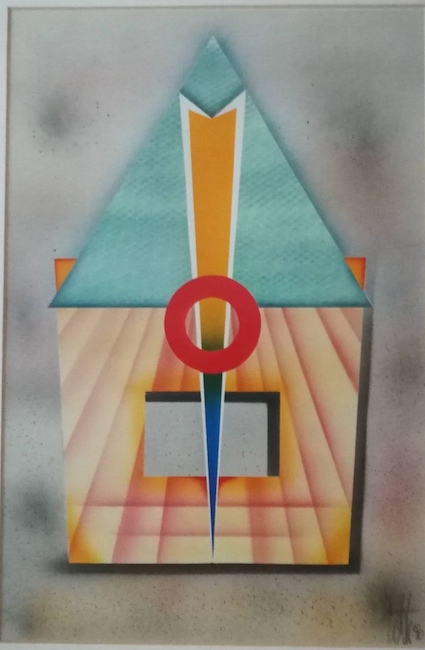
Non solo artista bensì anche autore di progetti di comunicazione e di design industriale, Harald Wiesner è stato uno dei maggiori esponenti austriaci dell’Aerografia, conosciuto e apprezzato anche all’estero per le sue opere misteriose e metafisiche; nel corso della sua carriera ha prodotto opere di grande impatto, capaci di andare a stimolare la mente, la riflessione dell’osservatore che si sente avvolto dall’enigma costituito dalle immagini realizzate dall’artista.
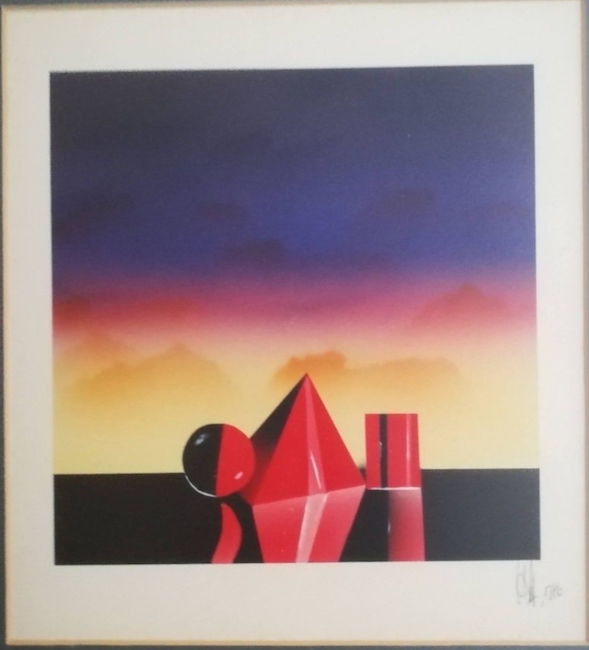
In Red Elements (Elementi rossi) pone tre figure geometriche in color rosso lacca al centro della composizione mettendo in contrasto e contrapposizione il loro rigore e il colore netto che le contraddistingue con lo sfondo più aereo e sfumato, come se in qualche modo volesse evidenziare quanto l’attenersi a tutto ciò che è rigido, a tutto ciò che è sottoposto a regole schematiche, sia in realtà solo un’apparente appiglio, un volersi aggrappare a certezze che nella realtà esterna non esistono; quella volatilità del cielo racconta all’osservatore quanto il caos entri prepotentemente e costantemente a far parte della quotidianità, a sparpagliare le carte e sovvertire l’ordine a cui l’individuo si aggrappa per non destabilizzarsi. Il rosso rappresenta la determinazione e anche il mistero che si nasconde oltre l’apparire di concetti prestabiliti, matematici, che però non trovano realizzazione nella realtà.
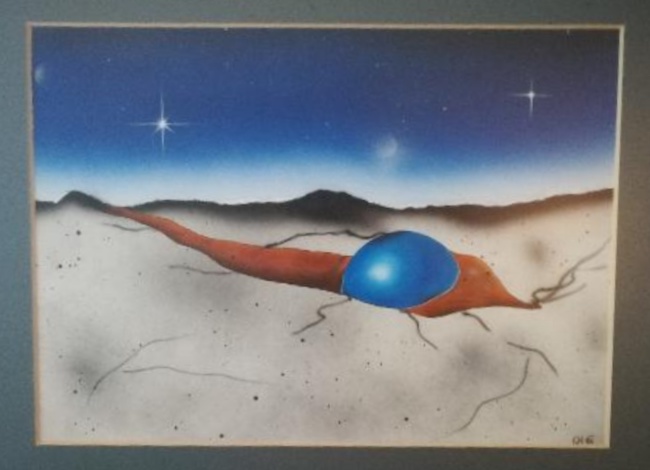
In Landing (Atterraggio) Wiesner narra di un luogo indefinito, un posto sospeso tra cielo e terra, tra fantasia e tangibilità, dove le crepe che solcano il paesaggio lunare sembrano essere metafora delle sofferenze, quelle tracce indelebili che avvolgono l’interiorità e che spesso non riescono a essere alleviate o cancellate anche davanti all’arrivo di un elemento morbido, come l’emisfero azzurro che appare come un dono, una possibilità di lasciarsi alle spalle quelle cicatrici e ricominciare da quell’inatteso spunto; oppure al contrario le crepe contraddistinguono il terreno arido che avvolge l’interiorità di chi non è capace di lasciarsi andare agli accadimenti malgrado questi giungano in maniera forte e incisiva, così in questo caso l’emisfero vuole nutrire la secchezza del terreno, fornire una nuova possibilità di rigenerazione attraverso l’assorbimento di un inedito modo di vedere le cose, un approccio più morbido ed empatico risolutivo rispetto alla chiusura emotiva precedentemente manifestata e, per questo, arricchente.
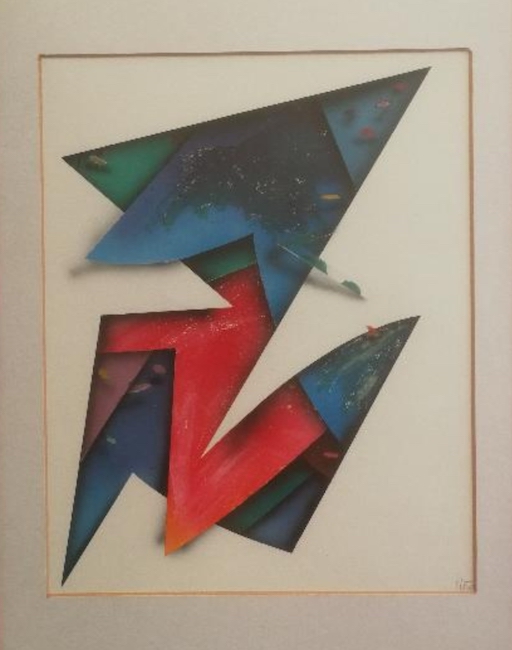
Nell’opera Confusion (Confusione) l’artista compone una sovrapposizione di colori e di materiale, a rappresentare la stratificazione della vita, di tutti gli accadimenti che si susseguono e che cambiano completamente la realtà preesistente, quella che aveva costituito una base sicura, un punto fermo in grado di infondere stabilità che poi però viene completamente demolita da ciò che accade in seguito. La sedimentazione che ne segue genera instabilità e confusione, ma al tempo stesso è necessaria per un’evoluzione personale, per la coscienza delle proprie forze e delle proprie capacità di reagire e di uscire dal caos per ricostruire un nuovo ordine.
In Clouds (Nuvole) invece Harald Wiesner abbandona il rigore geometrico e si lascia andare a un approccio più figurativo e decisamente più morbido, quasi a suggerire all’osservatore quanto sia importante avere un atteggiamento aperto ed elastico nei confronti di un’esistenza che è unica e irripetibile e dunque non dovrebbe essere vissuta in funzione di un solo binario prestabilito e preventivamente pianificato bensì sarebbe molto meglio lasciarsi andare morbidamente al flusso degli eventi senza però perdere il proprio equilibrio. La capacità camaleontica di adeguarsi a ciò che accade non è una debolezza, al contrario, è un punto di forza che induce a non investire energie per opporsi rigidamente, scegliendo di impiegarle per aggirare gli ostacoli e trovare un nuovo modo di risorgere.
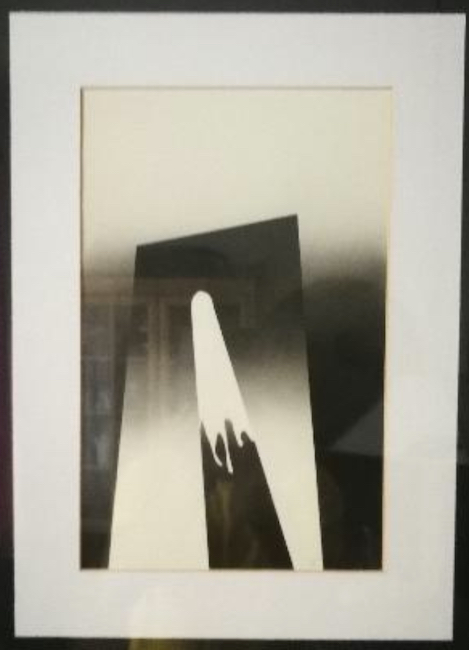
Artista di grande esperienza, Harald Wiesner ha partecipato nel corso della sua lunga carriera a molte mostre collettive e personali, giungendo a essere conosciuto a livello internazionale per la sua padronanza nell’uso della tecnica che ha contraddistinto tutto il suo percorso creativo.
HARALD WIESNER-CONTATTI
Email: harald.wiesner@chello.at
Sito web: https://publicartists.online/en/artists/harald-wiesner/
Facebook: https://www.facebook.com/hari0306
Instagram: https://www.instagram.com/hwa_photographie/
Harald Wiesner’s Airbrush technique, hovering between Geometric Abstractionism and Metaphysical Realism
Throughout the history of modern art, it have been discovered artistic techniques that have revolutionised the creative process and that, mixed with pressing expressive innovations, have succeeded in giving rise to new languages, based on the natural inclination of each artist. Today’s protagonist has based his entire production on a particular pictorial approach that has become one of the cornerstones of a number of subsequent artistic movements.
Airbrush is a painting method that has probably been used since remote, primitive times, when cave paintings often showed handprints surrounded by reddish pigments. Obviously, the technique was rudimentary and far away from the refinement and expansion it underwent around the 1950s, when some artists began experimenting with air painting on a wide range of surfaces. Initially developed as an industrial technique for the quick colouring of large areas and car bodies, Airbrush soon began to be used to give colour to black and white photographs, the period before the discovery of the colour technique, becoming more and more interesting in the experimental art world of the late 19th and early 20th century. It was, however, with Pop Art and American Photorealism that it began to be considered an art form or part of the creative process of some of the artists of that time. From walls to paper, from wood to metals, from leather to textiles, spray painting fascinated many exponents not only of Pop Art and Photorealism but also of Hyperrealism and later also of contemporary Street Art. The complicated process consists not only in creating protective sheets around the outline of the image the artist wishes to create, but also in applying the colour evenly, masterfully managing the spray of the air gun that is fundamental to this technique. The protective sheets were the ancestors of stencils, created by street artists who, given the transgressive nature of their way of making art, need speed of execution to avoid being caught in the act.
The apparent simplicity of execution is accompanied by great skill in graphic design, an essential basis for the final creation of the artwork, and the ability to dose the paint to overlap the layers without completely covering the underlying ones, thus creating three-dimensional and engaging images. Often used in graphic design and advertising, this technique is a complement to a more classic, more manual style of painting that does not disdain the innovation and completeness of a more glossy finish, using opaque or acrylic colours. Austrian artist Harald Wiesner was a pioneer of this technique in the 1980s, a master who managed to combine his passion for Geometric Abstractionism, in which metaphysical connotations very often emerge, with the technique of Aeorgraphy; his ability to use the air jet amazes and at the same time fascinates the observer who is drawn into the concepts that emerge from the works. All strictly on paper, Wiesner’s paintings seem to be an analysis of contemporary life, that balance between reality and the imaginary, between pragmatism and dreams that enveloped the man of the late twentieth century as much as that of the twenty-first one, constantly poised between form and substance, between the inclination towards beauty and the latent question of how much aesthetics is enough if it does not contain any substance.
Not only an artist but also author of communication and industrial design projects, Harald Wiesner has been one of Austria’s leading exponents of Airbrush, known and appreciated abroad for his mysterious and metaphysical artworks. Throughout his career he has produced paintings of great impact, capable of stimulating the mind and reflection of the observer who feels enveloped by the enigma posed by the artist’s images. In Red Elements, he places three geometric figures in lacquer red at the centre of the composition, contrasting their rigour and the sharp colour that distinguishes them with the more airy, shaded background, as if to emphasise in some way how adherence to all that is rigid, to all that is subject to schematic rules, is in reality only an apparent foothold, a desire to cling to certainties that do not exist in external reality; the volatility of the sky tells the observer how chaos is an overbearing and constant part of everyday life, shuffling the cards and subverting the order to which the individual clings in order not to become destabilised. Red represents determination and also the mystery that hides beyond the appearance of pre-established, mathematical concepts that are not realised in reality.
In Landing, Wiesner tells of an undefined place, a place suspended between heaven and earth, between fantasy and tangibility, where the cracks that furrow the lunar landscape seem to be a metaphor for suffering, those indelible traces that envelop the inner self and which often cannot be alleviated or erased, even when faced with the arrival of a soft element, such as the blue hemisphere, which appears as a gift, a chance to leave behind those scars and start again from that unexpected starting point; or, on the contrary, the cracks mark the arid ground that envelops the interiority of those who are unable to let go of events despite the fact that they come in a strong and incisive manner, so in this case the hemisphere wants to nourish the dryness of the ground, to provide a new possibility of regeneration through the absorption of a new way of seeing things, a softer and more empathic approach that resolves the emotional closure previously manifested and, for this reason, enriching. In Confusion, the artist composes a superimposition of colours and materials to represent the stratification of life, of all the events that follow one another and completely change the pre-existing reality, that which had constituted a secure base, a fixed point capable of instilling stability, which is then completely demolished by what happens next.
The sedimentation that follows generates instability and confusion, but at the same time it is necessary for a personal evolution, for the awareness of one’s own strengths and abilities to react and to emerge from chaos in order to reconstruct a new order. In Clouds, on the other hand, Harald Wiesner abandons geometric rigour and adopts a more figurative and decidedly softer approach, almost as if to suggest to the observer how important it is to have an open and flexible attitude towards an existence that is unique and unrepeatable and therefore should not be lived according to a single pre-established and pre-planned track, but it would be much better to let oneself go gently with the flow of events without losing one’s balance. The chameleon-like ability to adapt to what is happening is not a weakness, on the contrary, it is a strength that leads one not to invest energy in rigid opposition, but rather to use it to circumvent obstacles and find a new way to rise again. Experienced artist, Harald Wiesner has taken part in many group and solo exhibitions throughout his long career, and has become internationally renowned for his mastery of technique, which has characterised his entire creative career.


